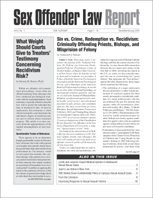Combining Strangulation and Sexual Abuse as Tools of Intimate Partner Abuse
Author: Kelsey McKay, J.D..
Source: Volume 24, Number 01, December/January 2023 , pp.10-15(6)

< previous article |next article > |return to table of contents
Abstract:
Over the last two decades, most states have passed “strangulation” legislation, often targeted to specifically address the risk and seriousness of this violence within IPV. The use of nonfatal strangulation (NFS) and fatal strangulation (FS) within the context of IPV is well established in research. IPV in which strangulation is present often involves sexual assault. Strangulation as part of IPV is a significant predictor of increasing lethality, and even more so when all three abuses overlap—IPV, sexual assault, and strangulation. The impact and significance of this combination of risk factors is the focus of this article. Criminal justice professionals and medical communities have struggled to adequately identify, document, and assess crimes involving strangulation (impeding a person’s ability to breath by constricting the neck) or any other form of asphyxiation (a death caused by depriving a person of oxygen). These failures hinder the successful prosecution of offenders. As this article explains, specific challenges exist in identifying this type of criminal activity, and they must be considered when developing policy in response to these gendered crimes. Understanding the way offenders use strangulation in the context of IPV and the associated risk of homicide will improve law enforcement practices so that dangerous offenders will be held accountable.Keywords: Prevalence of Strangulation in IPV; Health Effects; Increased Risk of Homicide; Why Sexual Offenders Use Asphyxiation; Strangulation as a Control Tactic; Consent and Compliance
Affiliations:
1: RESPOND Against Violence.